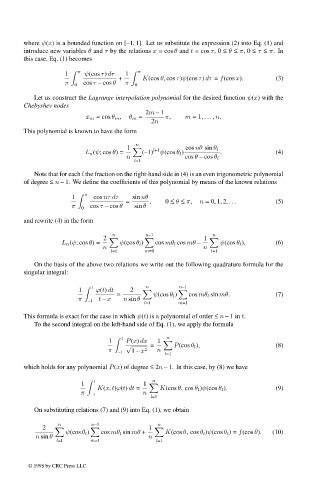Page 647 - Handbook Of Integral Equations
P. 647
where ψ(x) is a bounded function on [–1, 1]. Let us substitute the expression (2) into Eq. (1) and
introduce new variables θ and τ by the relations x = cos θ and t = cos τ,0 ≤ θ ≤ π,0 ≤ τ ≤ π.In
this case, Eq. (1) becomes
π π
1 ψ(cos τ) dτ 1
+ K(cos θ, cos τ)ψ(cos τ) dτ = f(cos x). (3)
π cos τ – cos θ π
0 0
Let us construct the Lagrange interpolation polynomial for the desired function ψ(x) with the
Chebyshev nodes
2m – 1
x m = cos θ m , θ m = π, m =1, ... , n.
2n
This polynomial is known to have the form
n
1 l+1 cos nθ sin θ l
L n (ψ; cos θ)= (–1) ψ(cos θ l ) . (4)
n cos θ – cos θ l
l=1
Note that for each l the fraction on the right-hand side in (4) is an even trigonometric polynomial
of degree ≤ n – 1. We define the coefficients of this polynomial by means of the known relations
π
1 cos nτ dτ sin nθ
= , 0 ≤ θ ≤ π, n =0, 1, 2, ... (5)
π cos τ – cos θ sin θ
0
and rewrite (4) in the form
n n–1 n
2 1
L n (ψ; cos θ)= ψ(cos θ l ) cos mθ l cos mθ – ψ(cos θ l ). (6)
n n
l=1 m=0 l=1
On the basis of the above two relations we write out the following quadrature formula for the
singular integral:
n
n–1
1 1 ϕ(t) dt 2
= ψ(cos θ l ) cos mθ l sin mθ. (7)
π t – x n sin θ
–1
l=1 m=1
This formula is exact for the case in which ψ(t) is a polynomial of order ≤ n – 1in t.
To the second integral on the left-hand side of Eq. (1), we apply the formula
n
1 1 P(x) dx 1
√ = P(cos θ l ), (8)
π –1 1 – x 2 n
l=1
which holds for any polynomial P(x) of degree ≤ 2n – 1. In this case, by (8) we have
n
1 1 1
K(x, t)ϕ(t) dt = K(cos θ, cos θ l )ψ(cos θ l ). (9)
π –1 n
l=1
On substituting relations (7) and (9) into Eq. (1), we obtain
n n–1 n
2 1
ψ(cos θ l ) cos mθ l sin mθ + K(cos θ, cos θ l )ψ(cos θ l )= f(cos θ). (10)
n sin θ n
l=1 m=1 l=1
© 1998 by CRC Press LLC
© 1998 by CRC Press LLC
Page 630

